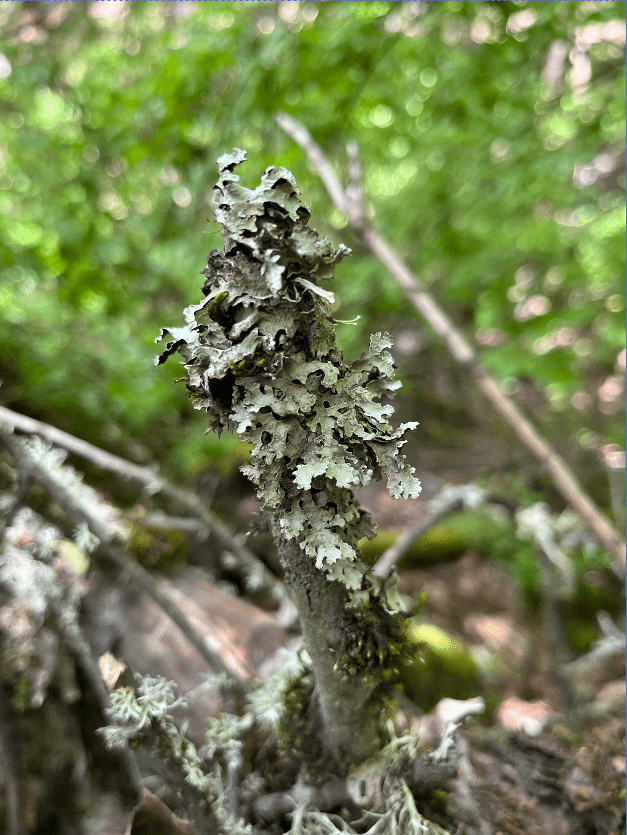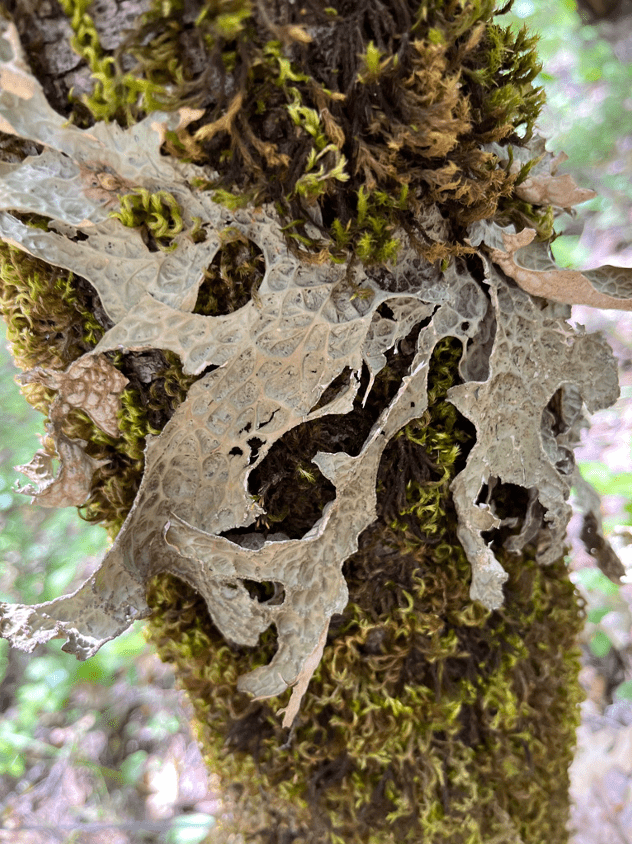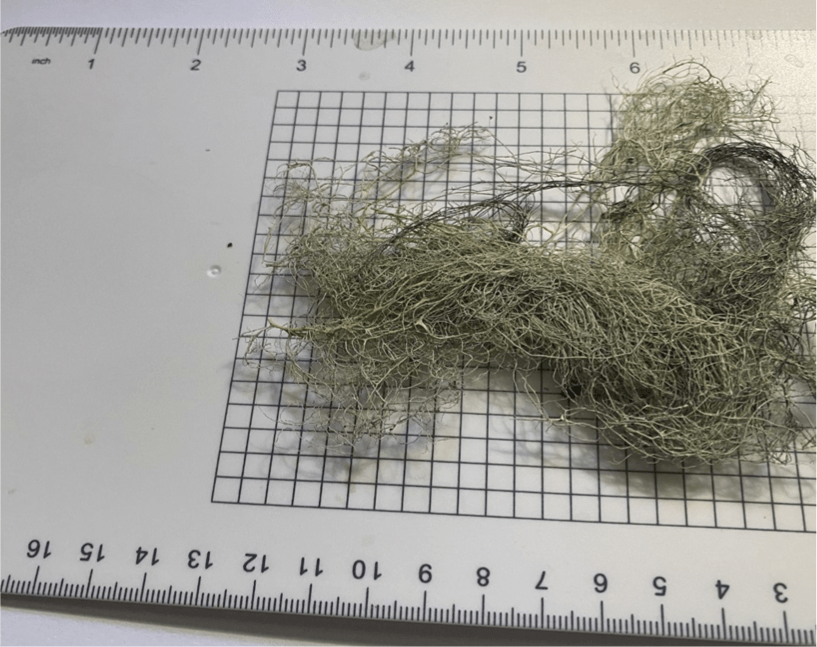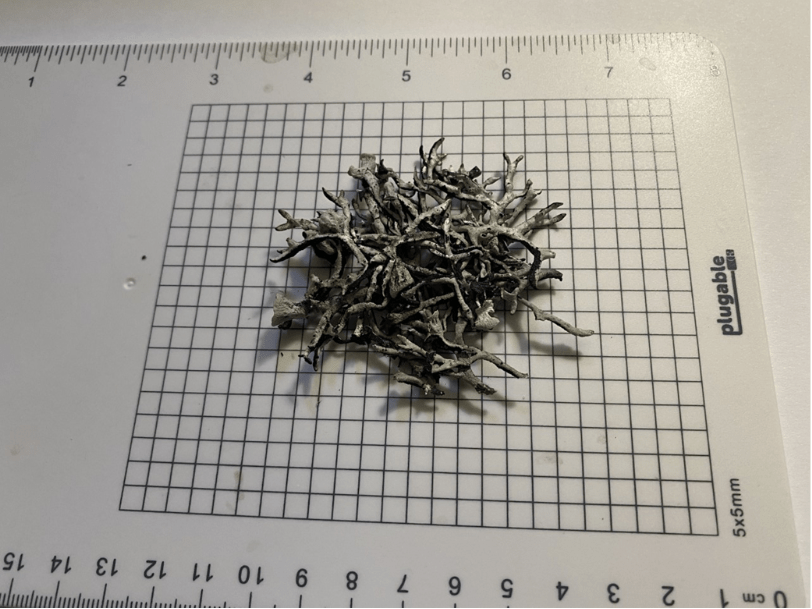
LMI Team Receives Specialized Biomonitoring Training
Climate Mitigation & Adaptation, Energy & Environment, Data & AnalyticsLMI’s environmental planning team (Jennifer Brown, Ashley Rivero, and David Walls) completed lichen biomonitoring training sponsored by the U.S. Forest Service, Region 6. The team spent three days in the Rouge River–Siskiyou National Forest’s Kalmiopsis Wilderness, where they learned how to set a biomonitoring plot, calculate tree density, identify lichen plant communities, set abundance scores, and collect tissue samples for analysis.
Lichens result from the interrelationship between an alga (known as a photobiont) and a fungus. Lichens consist of two organisms that produce food via photosynthesis. Either green algae or cyanobacteria (known as blue-green algae) form a symbiosis (live together) with a fungus, producing in a new organism neither alga nor fungus. The success of these partnerships has created almost 14,000 different types of lichens.
Because lichen biomonitoring can help evaluate whether certain concentrations of air pollutants are causing biological damage, the U.S. Forest Service has been collecting lichen data since the 1970s, with nationwide emphasis beginning in 1993. Lichens can also facilitate biomonitoring of climate change and its effects on living organisms. Like most organisms used for biomonitoring, lichens are analogous to the canary in the coal mine: if lichens are affected by air pollution and climate change, then other living things, including humans, may be as well.
Like most organisms used for biomonitoring, lichens are analogous to the canary in the coal mine: if lichens are affected by air pollution and climate change, then other living things, including humans, may be as well.
-
![Group photo from the USFS lichen biomonitoring training in the Rouge River–Siskiyou National Forest. Lower row (left to right): Ashley Rivero (LMI), Bri Bernstein (U.S. Forest Service [USFS]), and Amanda Hardman (USFS). Upper row (left to right) Jennifer Brown (LMI), David Walls (LMI), and Teresa Bird (USFS).](/sites/default/files/styles/p_media_carousel_image/public/2024-08/GroupOfLMIers_Outdoors_900x675.jpg?itok=NAlAUq_s)
Group photo from the USFS lichen biomonitoring training in the Rouge River–Siskiyou National Forest. Lower row (left to right): Ashley Rivero (LMI), Bri Bernstein (U.S. Forest Service [USFS]), and Amanda Hardman (USFS). Upper row (left to right) Jennifer Brown (LMI), David Walls (LMI), and Teresa Bird (USFS).
-

Platismatia glauca (Photo: David Walls)
-

Lobaria pulmonaria (Photo: David Walls)
Biomonitoring uses three basic types of lichen growth forms: foliose (leafy with obvious upper and lower surfaces), fruticose (three-dimensional and filamentous or threadlike with small scales), and crustose (crust-like, similar to a stain, paint, or dust). Lichens prefer a stable substrate for growth, such as tree bark or rock.
Air pollutants that can be biomonitored via lichens include nitrogen compounds, ammonia, nitric acid, sulfur compounds, sulfur dioxide, sulfuric acid, fluorides, ozone, aromatic hydrocarbons, polychlorinated biphenyls, radioactive compounds, and heavy metals (like copper, zinc, and lead).
The LMI team is continuing its training and understanding of lichen biomonitoring in the national forests and grasslands of Texas. Working with the forest staff, the team will establish several monitoring plots with a radius of 34.7 meters (114 feet) across all four Texas national forests (Angelina, Davy Crockett, Sabine, and Sam Houston). Sam Houston National Forest will receive the most monitoring plots due to its downwind proximity to the Houston air pollution plume, which often has elevated levels of ozone, hydrocarbons, sulfur compounds, nitrogen compounds, and other air pollutants. The Angelina, Davy Crockett, and Sabine national forests will serve as controls for the monitoring since they are exposed to lower levels of air pollution.
Understanding how climate change affects nature aids scientists immensely. Because indicator species, such as lichen, are sensitive enough to serve as an early warning system, they can be monitored for elevated levels of pollutants. This knowledge helps customers place facilities and fleets better. This training adds to the toolkit of the specialists at LMI, enhancing our best-in-class service for government organizations.
Understanding how climate change affects nature aids scientists immensely. Because indicator species, such as lichen, are sensitive enough to serve as an early warning system, they can be monitored for elevated levels of pollutants.
-

Alectoria sarmentosa (Fruticose Lichen) (Photo: David Walls)
-

Hypogymnia imshaugii (Photo: David Walls)
This training adds to the toolkit of the specialists at LMI, enhancing our best-in-class service for government organizations.

Infrastructure Resilience
LMI helps federal agencies strengthen infrastructure resiliency with data-driven strategies that respect natural resources and support sustainability.


